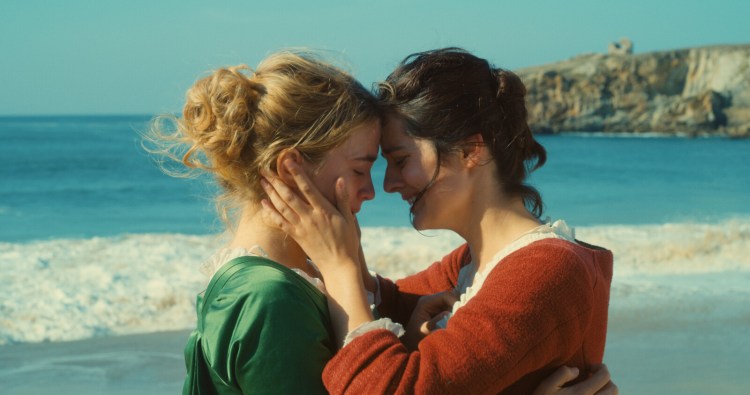I approached writer-director Céline Sciamma’s “Portrait of a Lady on Fire” on tiptoes, fearing I’d have to review another soft textured “Lesbo Love” pageant of sweaty, writhing bodies. Instead, I was surprised to find a delicately woven romance and a needlepointed memory about an ancient love stowed gently away in an attic.
We learned an important lesson about the bewitchingly beautiful Marianne (Noemie Merlant) from scene one, when, as she is being rowed ashore by 16 hearty merchant men, her crate of canvasses and paints falls overboard. Marianne dives in to the angry sea to save it. The seamen are stunned. This is clearly not a lady of leisure.
Marianne, a painter and daughter of a well-known painter, finds herself on the impossibly bleak coast of 18th-century France, where she has been hired by an older widow, La Comtesse, (Valeria Golino) to paint the portrait of her daughter Heloise, a young woman whom we learned has just left a semester in the convent.
One look at Heloise (Adele Haenel) and we are comforted in knowing that such features will be spared the darkness of sacred seclusion.
The portrait, it seems, has been ordered to firm the former nun’s marriage to a Lira heavy Italian.
If he likes the portrait, La Comtesse tells Marianne, he will take Heloise to his bed. This is, you can see, all before Tinder and Facebook.
Madame informs Marianne that Heloise is a bit of a problem. The troubled daughter doesn’t really want her portrait painted; there was, it seems, another artist who just didn’t work out.
He left in a huff after Heloise took a damp cloth to his work. So mother presents Marianne as a “companion.”
With all of that, we’re imagining our Heloise to be a stomping, bad-tempered pain in the corset. Happily, we meet a soft featured woman-child with sun stroked angelic curls, and deep blue eyes that would take down even the most pious of popes.
Artist and reluctant model approach one another cautiously, and the woman-child who is herself a blank canvass offers few words and cold glances.
On first days, they walk silently on the windy beach together in small quiet movements, then slowly words pop up between them like sand pebbles, until the white space between them begins to fill up with a few colors, muted at first, and then, growing from cautious sketches to bold strokes, fragments of a portrait take shape.
The dialogue between them, spoken almost like teacher to child, slowly grows more personal until the space between them fades completely when Marianne, at the first posing, senses Heloise’s discomfort, and whispers, “I’d hate to be in your place.”
Heloise replies, “We’re in the same place. Exactly the same place. Come here. Come. Step closer.”
What Marianne does next, brings us to that eagerly awaited moment when the first sparks are struck that will ignite the flames we’ve been promised, and Sciamma’s words and Claire Mathon’s camera come together in a rush of heat that will, at least for a moment, grab your breath away.
“Portrait of a Lady on Fire” is a slow but ultimately satisfying burn, and despite its beauty, it can at times, in its two hours, grow somewhat close to tedium, mostly due to Sciamma’s fondness for very long pauses and floating closeups. Still, her artistry and the talent of her players, holds fast. Sciamma’s film is beautifully shot and well played, a treat for the eyes and heart and a respite from the chaos around us.
J.P. Devine, of Waterville, is a former stage and screen actor.
Comments are not available on this story.
Send questions/comments to the editors.



